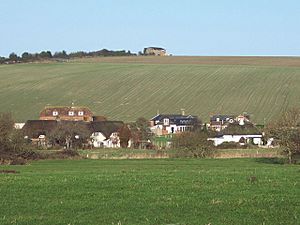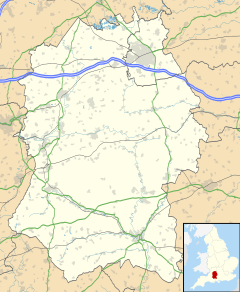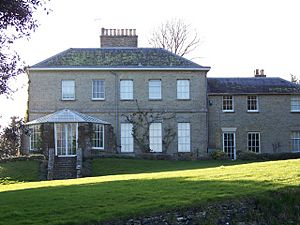Bishopstone, Salisbury facts for kids
Quick facts for kids Bishopstone |
|
|---|---|
 Houses under Netton Down, Bishopstone |
|
| Population | 717 (in 2021) |
| OS grid reference | SU069257 |
| Civil parish |
|
| Unitary authority |
|
| Ceremonial county | |
| Region | |
| Country | England |
| Sovereign state | United Kingdom |
| Post town | Salisbury |
| Postcode district | SP5 |
| Dialling code | 01722 |
| Police | Wiltshire |
| Fire | Wiltshire |
| Ambulance | Great Western |
| EU Parliament | South West England |
| UK Parliament |
|
| Website | Village |
Bishopstone is a village and civil parish in Wiltshire, England. It sits in the beautiful Ebble valley. The village is about 5.5 miles (8.9 km) south-west of Salisbury.
The parish of Bishopstone is right on the border with Hampshire. It includes a smaller village called Croucheston and a tiny settlement known as The Pitts (now Pitts Road).
Contents
History of Bishopstone
People have lived in the Bishopstone area for a very long time. There are signs of settlements from prehistoric times. For example, a bowl barrow (an ancient burial mound) was found near Croucheston Down Farm. Also, Grim's Ditch, a prehistoric earthwork, marks the southern edge of the parish.
A Roman road once crossed the river near Throope. This road connected Old Sarum to Dorchester.
Before the 900s, much of the land here was part of a large estate called Downton. In the early 900s, a manor in Bishopstone was given to Winchester Abbey. At that time, the whole river valley was known as Ebbesborne. The village itself was also called Ebbesborne.
Later, people started adding "Bishop's" to the name to tell it apart from another village in the same valley. Eventually, this village became known as Bishopstone. The other village became Ebbesbourne Wake.
The Domesday Book was a famous survey from 1086. It divided the Chalke Valley into eight main areas called manors. These included Bishopstone, which was part of a manor called Stradford.
The parish of Bishopstone used to have six old townships, possibly since Saxon times. Each of these had land reaching the river. North of the river were Bishopstone (where the church is), Netton, and Flamston. South of the river were Throope, Faulston, and Croucheston. The area known as The Pitts grew into a small roadside community in the 1800s.
Faulston Manor's Story
Faulston was once a manor, which is like a large estate with a main house. In 1328, Thomas Benton inherited it. Later, the estate was taken away from Sir Robert Baynton in 1475. This happened because he supported King Henry VI during a battle. The land was given to John Cheyne, but it was returned to Sir Robert's son in 1503.
Sir Edward Bayntun, a soldier and courtier, was a favorite of King Henry VIII. He worked for Queen Anne Boleyn and other queens. Later, the manor was sold to Charles Vaughan in 1577.
His grand-nephew, Walter Vaughan, took over in 1584. He was a Member of Parliament and a local official. A famous royal, Arbella Stuart, even stayed at Faulston House for over a month in 1603.
During the English Civil War, Sir George Vaughan, Walter's son, fought for the King (the Royalists). When Parliament's army took over Wiltshire in 1645, they used Sir George's house. It became a place where they decided how much Royalist supporters had to pay in fines. In 1649, the house's defenses were ordered to be destroyed. Sir George then sold the manor to the Earl of Pembroke.
The house was rebuilt, and you can still see parts of an old moat. The Pembroke family owned the property until 1919, when the farm was sold to the person who was renting it.
Villages and Buildings
The main Bishopstone village area is quite small. It has the church, the old rectory, Manor Farm, and a few houses. There are signs that a larger medieval village once stood east of the church, but it is now gone.
The rectory, now called Bishopstone House, was built around 1820. It was designed by an architect from Bath. It was sold for private use in the 1950s. Manor Farm was built in the early 1800s. Its house is made of red brick, and its farm buildings use a mix of brick and flint.
Throope has always been a small place. The main house there is Throope Manor. It was built in the early 1700s and made bigger in 1935. It might even include parts of a house from the 1600s.
Netton grew as a village along what are now Pitts Lane and Netton Street. Netton Old Farmhouse is a two-story building with a thatched roof. It has a date tablet from 1637. The old Three Horseshoes Inn, from the 1700s, is also in this area. The village hall, built in 1885, is here too. The White Hart pub, which has been a pub since 1792, has a building from the 1800s.
Flamston was another village that stretched out along a road. Today, only a farm and two thatched cottages remain on Flamston Street.
Croucheston House is a farmhouse from the late 1700s, built with a mix of brick and flint. Chapel Lane has the old Methodist chapel and Sudbury House, which dates back to the late 1600s. 'Old Rafters' is a cottage from the 1500s. Near the river is a corn mill. It was used until the 1990s and might be on the site of a mill from the 1200s.
At Faulston, many old farmhouses were left empty in the Middle Ages. Only the manor house and its farm remained. The current Faulstone House was rebuilt around 1800. A tall dovecote (a building for doves) from the early 1600s is still there. It is a very important historical building. It might have been part of the old house's defenses. Farm buildings across the road were built in the mid-1800s. Faulston also had a corn mill, called Lower Mill, which was used until the 1940s.
Churches and Chapels
St John the Baptist Church
The Church of England parish church of St John the Baptist is a very old and important building. You can still see parts of a 1100s building in its walls. The church was rebuilt in the 1300s. It has special vaulted ceilings in some parts. The low tower was built around 1406.
In the 1800s, the church was restored. This included rebuilding the porch and adding a new east window. Experts describe the church as large and impressive. Its style is similar to the church at Edington Priory.
Outside the church, there are several interesting monuments. One small stone structure shelters a 1200s tomb. It might have been moved from somewhere else.
Inside, the priest's door has a fancy arch. There are also beautiful carved seats for the priests. The vaulted roofs of the chancel and south transept are highly praised. The east window from 1898 was paid for by a former rector, George Augustus Montgomery.
In the north transept, there is a richly decorated tomb. In the south transept, there is a very ornate monument from 1844. It was designed by A. W. Pugin and is a memorial to Rev. Montgomery.
The octagonal font (for baptisms) is from the 1300s. Some of the wooden parts inside the church were brought from Seville in 1838. The three bells in the tower were made in 1583, 1587, and 1652.
Church History
For a long time, the church had both a rector and a vicar. But from 1584, the same person usually held both jobs. In 1815, these two jobs were combined. In 1925, the church of Stratford Tony joined with Bishopstone. Today, Bishopstone church is part of a larger group of churches in the Chalke Valley.
Famous Church Leaders
Some important people have served as rectors or vicars here:
- Nicholas Bildeston: He was a church leader in Winchester and Salisbury, and rector here from 1423 to 1441.
- John Earle: He was rector from 1639. Later, he became a chaplain to King Charles II and then a Bishop of Salisbury.
- John Younger: Rector from 1688 to 1728, and Dean of Salisbury.
- George Augustus Montgomery: He was rector from 1821 to 1842. He helped renovate the church and paid for the village school. He also left money for a charity to help villagers buy coal.
- Francis Lear: Rector from 1842 until his death in 1850. His son, also named Francis, was also a rector here and later a church leader in Salisbury.
Other Religious Sites
A Primitive Methodist chapel opened in 1833 at Croucheston. It was used until 1978.
Local Life
A school was built on Pitts Road in 1843. It taught children of all ages until 1932, when it became a school just for younger children. It closed in 1977 because there were not enough pupils.
Bishopstone has a village hall, which is a place for community events. It also has a pub called the White Hart. There used to be another pub, the Three Horseshoes, but it closed in 2002.
Throope Down is a special natural area. It is known for its many different types of grasses, herbs, and beautiful orchids.





